
Saint John is a seaport city located on the Bay of Fundy in the province of New Brunswick, Canada. It is Canada's oldest incorporated city, established by royal charter on May 18, 1785, during the reign of George III. The port is Canada's third-largest by tonnage with a cargo base that includes dry and liquid bulk, break bulk, containers, and cruise. The city was the most populous in New Brunswick until the 2016 census, when it was overtaken by Moncton. It is currently the second-largest city in the province, with a population of 69,895 over an area of 315.59 km2 (121.85 sq mi).

The Ambassador Bridge is an international suspension bridge across the Detroit River that connects Detroit, Michigan, United States, with Windsor, Ontario, Canada. Opened in 1929, the toll bridge it is the busiest international border crossing in North America in terms of trade volume, carrying more than 25% of all merchandise trade between the United States and Canada by value. A 2004 Border Transportation Partnership study showed that 150,000 jobs in the Detroit–Windsor region and US$13 billion in annual production depend on the Detroit–Windsor international border crossing.

The Prince Edward Viaduct System, commonly referred to as the Bloor Viaduct, is the name of a truss arch bridge system in Toronto, Ontario, Canada, connecting Bloor Street East, on the west side of the system, with Danforth Avenue on the east. The system includes the Rosedale Valley phase and the Sherbourne Phase, an embankment built to extend Bloor Street East to the Rosedale Ravine from Sherbourne Street. The Don Valley phase of the system, the most recognizable, spans the Don River Valley, crossing over the Bayview Avenue Extension, the Don River, and the Don Valley Parkway.
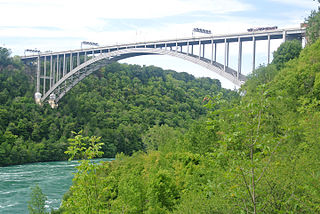
The Lewiston–Queenston Bridge, also known as the Queenston–Lewiston Bridge, is an arch bridge that crosses the Niagara River gorge just south of the Niagara Escarpment. The bridge was officially opened on November 1, 1962. It is an international bridge between the United States and Canada. It connects Interstate 190 in the town of Lewiston, New York to Highway 405 in the community of Queenston, Ontario. The Lewiston–Queenston Bridge is architecturally similar to the Rainbow Bridge at nearby Niagara Falls.
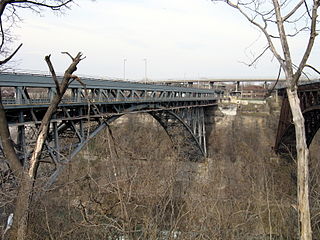
The Whirlpool Rapids Bridge, commonly known as the Whirlpool Bridge or the Lower Steel Arch Bridge, is a spandrel braced, riveted, two-hinged arch bridge that crosses the Canada–United States border, connecting the commercial downtown districts of Niagara Falls, Ontario, and Niagara Falls, New York. This bridge is located approximately 1.5 kilometres (0.9 mi) north of the Rainbow Bridge and about 2 kilometres (1.2 mi) from the Falls. It was acquired by the Niagara Falls Bridge Commission in January 1959. Immediately upstream is the similar arch-style Michigan Central Railway Bridge, which has been out of service since 2001.

The Jacques Cartier Bridge is a steel truss cantilever bridge crossing the Saint Lawrence River from Montreal Island, Montreal, Quebec, to the south shore at Longueuil, Quebec, Canada. The bridge crosses Saint Helen's Island in the centre of the river, where offramps allow access to the Parc Jean-Drapeau and La Ronde amusement park.

The Reversing Falls are a series of rapids on the Saint John River located in Saint John, New Brunswick, Canada, where the river runs through a narrow gorge before emptying into the Bay of Fundy.

The Mactaquac Dam is an embankment dam used to generate hydroelectricity in Mactaquac, New Brunswick. It dams the waters of the Saint John River and is operated by NB Power with a capacity to generate 670 megawatts of electricity from 6 turbines; this represents 20 percent of New Brunswick's power demand.
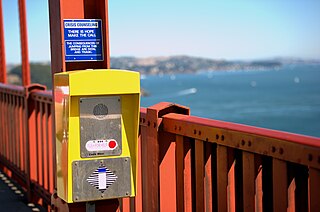
Jumping from a dangerous location, such as from a high window, balcony, or roof, or from a cliff, dam, or bridge, is an often used suicide method. The 2023 ICD-10-CM diagnosis code for jumping from a high place is X80*, and this method of suicide is also known clinically as autokabalesis. Many countries have noted suicide bridges such as the Nanjing Yangtze River Bridge and the Golden Gate Bridge. Other well known suicide sites for jumping include the Eiffel Tower and Niagara Falls.
A suicide bridge is a bridge used frequently by people to end their lives, most typically by jumping off and into the water or ground below. A fall from the height of a tall bridge into water may be fatal, although some people have survived jumps from high bridges such as the Golden Gate Bridge. However, significant injury or death is far from certain; numerous studies report minimally injured persons who died from drowning.

The Third Avenue Bridge is a landmark structure of the city of Minneapolis, Minnesota, United States, originally known as the St. Anthony Falls Bridge. It carries road traffic across the Mississippi River and upper fringes of Saint Anthony Falls. The multi-arched bridge meets with Third Avenue in downtown Minneapolis at its south end, but curves as it crosses the river, and connects with Central Avenue on its north end. The shallow "S" curve in the bridge was built to avoid fractures in the limestone bedrock that supports the bridge piers. The road is also designated Minnesota State Highway 65. Construction began in 1914, and it opened four years later in 1918. The bridge, which uses Melan arches of an open spandrel design, has been modified since that time. The 2,223-foot crossing was designed by city engineer Frederick W. Cappelen, who also created plans for other similar bridges in Minneapolis such as the Franklin Avenue Bridge. It cost US$862,254.00 at the time of construction.
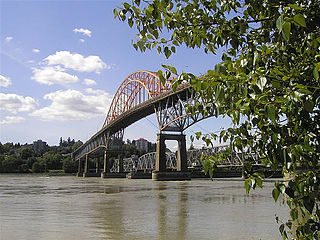
The Pattullo Bridge is a through arch bridge that crosses the Fraser River and links the cities of New Westminster and Surrey in Metro Vancouver, British Columbia. It was named in honour of Thomas Dufferin Pattullo, the 22nd Premier of British Columbia. A key link between Surrey and the rest of Greater Vancouver, the Pattullo Bridge handles an average of 75,700 cars and 3840 trucks daily, or roughly 20% of vehicle traffic across the Fraser River as of 2013.

The Washington Bridge is a 2,375-foot (724 m)-long arch bridge over the Harlem River in New York City between the boroughs of Manhattan and the Bronx. The crossing, opened in 1888, connects 181st Street and Amsterdam Avenue in Washington Heights, Manhattan, with University Avenue in Morris Heights, Bronx. It carries six lanes of traffic, as well as sidewalks on both sides. Ramps at either end of the bridge connect to the Trans-Manhattan Expressway and the Cross Bronx Expressway.
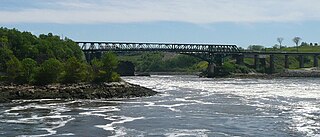
The Reversing Falls Railway Bridge is the name given to two different steel truss bridges crossing the Saint John River at the same location in Saint John, New Brunswick, Canada.

The Saint John Harbour Bridge is three-span crossing of Saint John Harbour at the mouth of the Saint John River in Saint John, New Brunswick, Canada. It opened in 1968.

The Chaudière Bridge crosses the Ottawa River about 1 km (0.6 mi) west of Parliament Hill, joining the communities of Gatineau, Quebec and Ottawa, Ontario, linking Rue Eddy in the Hull sector of Gatineau and Booth Street in Ottawa. The bridge is one portion of multiple spans constituting the Chaudière Crossing, which still contain portions of the first bridge linking Ottawa with Hull dating back to the time of Colonel By in the 1820s.

Marathon by the Sea was an annual marathon race held in Saint John, New Brunswick, Canada from 1995 to 2022. The race was a Boston Marathon qualifier, with 17 of the 77 runners qualifying in the 2012 edition of the run. The race was held in early August but Saint John's coastal climate has made the marathon known for its cool temperatures in spite of the summer season. The marathon was given a multi-page feature in Runner's World magazine, which called it "A race with a big heart and a warm smile -- and a perfect late-summer spot on the calendar... just right if you're looking for a break from the heat down south."
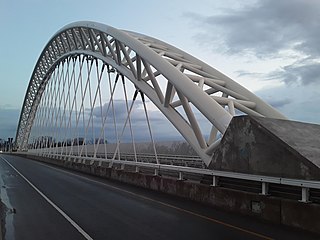
The Burgoyne Bridge is a bridge in St. Catharines, Ontario, Canada. The original bridge was built in 1915 by the Dominion Steel and Coal Corporation. In 2010, construction of a new Burgoyne Bridge was recommended by the Niagara Region. However, the project was not completed until 2016 due to the estimated cost. The new bridge is 333 meters long and features a 125-metre main span supported by a steel arch.


















